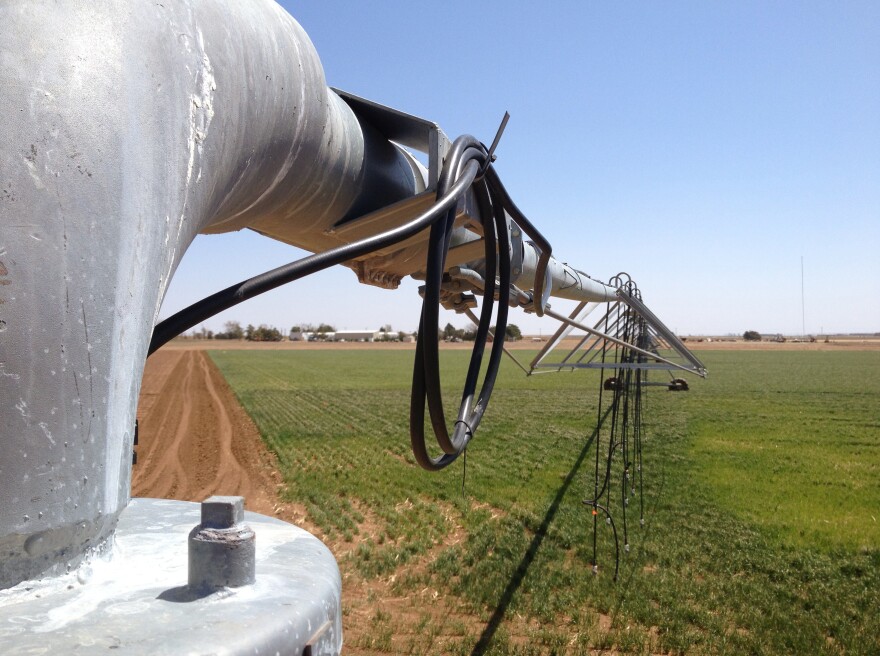When Sangu Angadi was traveling to his science center office in Clovis, New Mexico, one spring day, he was engulfed in the dust of a prairie windstorm. As a crop scientist, Angadi had a pretty good idea of the source of the dust – fallow fields that had dried to powder over the winter months. What he learned later would spur him into seeking new solutions to this decades-long, and worsening challenge.
Soon after returning to New Mexico State University’s Agricultural Science Center at Clovis, Angadi heard on a news broadcast that some people had been killed in a West Texas traffic accident caused by the low visibility conditions in the same storm. As he weighed the conditions that led to the deadly storm, an idea came to mind that promised numerous benefits, and the possibility of perhaps saving lives in the future.
The dust storm consequences added a heightened level of urgency to Angadi’s work in the College of Agricultural, Consumer and Environmental Sciences to study new ways to use water more efficiently. Such research is especially important in the Great Plains where heavy use of ancient water trapped in the Ogallala Aquifer had depleted the underground water level much faster than it was being recharged by rain and melting snow.
Angadi, a professor of crop stress physiology, had an idea that was simple yet innovative: why not create special, non-irrigated “circular buffer strips” within the irrigated fields in Eastern New Mexico and West Texas? With center-pivot irrigation systems widely used in the area’s farmlands, such buffer strips could provide protective conditions to shield young plants from wind and conserve water. Reduced water availability in recent years had caused many farmers to irrigate only two-thirds of their fields, with a third left fallow. Those fallow areas seemed like an ideal opportunity for the buffer strips project.
A field trial was established by Angadi and his fellow researchers at the Clovis Science Center in August 2016. The field includes five buffer strips among the pivot’s crop circle. Each 30-foot-wide buffer strip alternates with a 60-foot-wide crop strip. Six native perennial grasses – two cool season and four warm season – were planted and sensors were installed.
Angadi knew that reintroduction of perennial grasses to the Great Plains fields would bring many benefits, such as improved productivity, biodiversity, soil quality and organic matter content and better water infiltration and water holding capacity. The grasses helped reduce wind speed, evaporation, wind and soil erosion, sandblasting and runoff, and improved rain and snow capture in the climate conditions, or “microclimate,” closely surrounding the crop.
A very practical benefit of the buffer strips is increased access to the fields by heavy equipment for maintenance of the irrigation pivot itself and fewer well pressure problems.
Angadi has observed an improved water cycle, biodiversity, increased productivity, carbon sequestration and reduction in withdrawal from the Ogallala aquifer.
“Producers, researchers and private companies are excited with the concept,” Angadi said. “One farmer has planted circular grass buffers in three circles and many more are thinking of trying this method.”
Angadi said the technique creates good habitat for wildlife and the project offers a unique ability to train graduate and undergraduate students in multidisciplinary studies. The project is funded by a U.S. Department of Agriculture National Institute of Food and Agriculture Foundational Grant.
Also at the Clovis Science Center, researcher Rajan Ghimire is looking at innovative ways to improve agricultural production, with a focus on the soil health of the area. Ghimire, an assistant professor in the Department of Plant and Environmental Sciences, leads a team that is evaluating cover crops, conservation tillage systems and crop residue management practices intended to minimize soil organic carbon loss and improve nutrient cycling, soil health and water conservation in the area’s dryland and limited-irrigation cropping systems.
Regarding the alteration of tillage practices, Ghimire said, “Research on conventional tillage, strip-tillage and no-tillage comparison in dryland situations shows the many benefits of reducing tillage. Specifically, no-tillage in dryland corn-sorghum rotations has increased soil water storage, reduced soil erosion and maintained comparable crop yields.”
Ghimire and his team also are studying how cover crops, crop rotation and diversification and the input of biomass carbon can increase efficiency of water use. The researchers’ ultimate focus is to meet global food production needs while minimizing the impact on the environment and ensuring long-term environmental and economic sustainability of global agriculture. They hope to improve overall soil health, reduce greenhouse gas emissions from farmland and improve water use and conservation efficiency.
Funding for Ghimire’s work comes from USDA-NIFA as well as the USDA’s Natural Resources Conservation Service.
In an area of New Mexico where a history of high crop production is being threatened by a declining source of water, these and other College of ACES researchers are using innovation, dedication and know-how to help move from concern to confidence in the economic viability of agriculture in the region.
Information from NMSU


